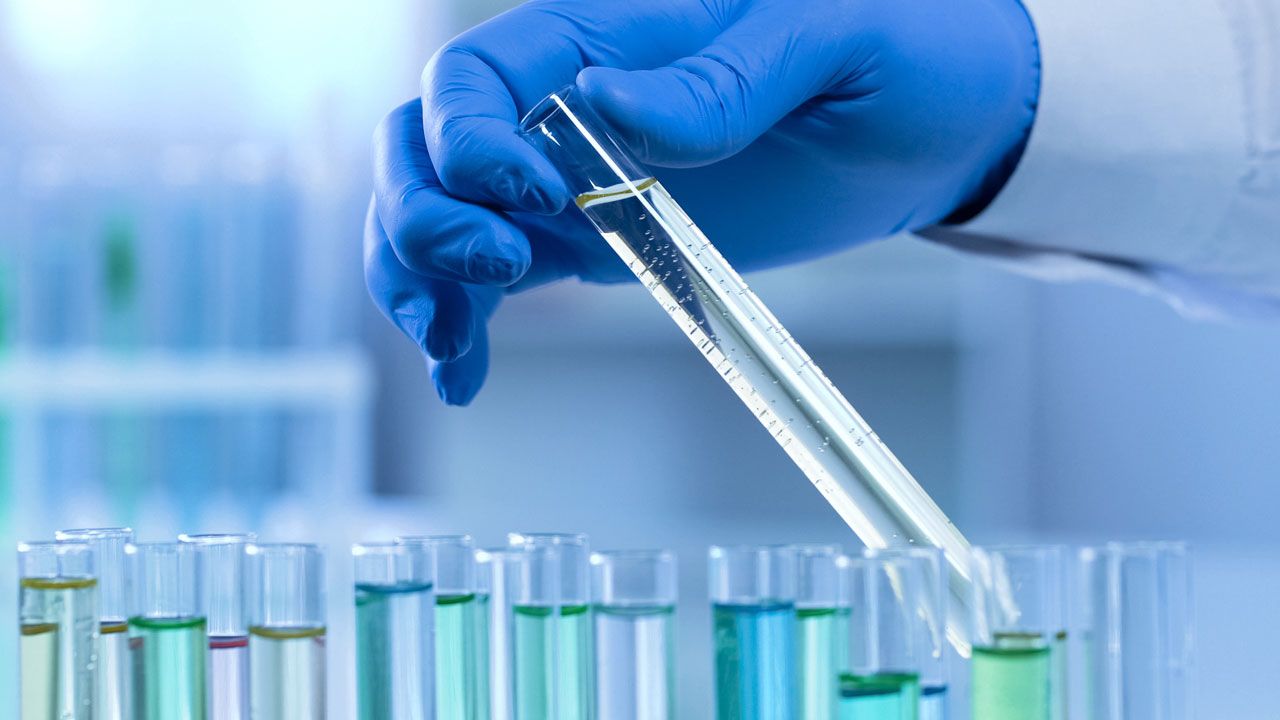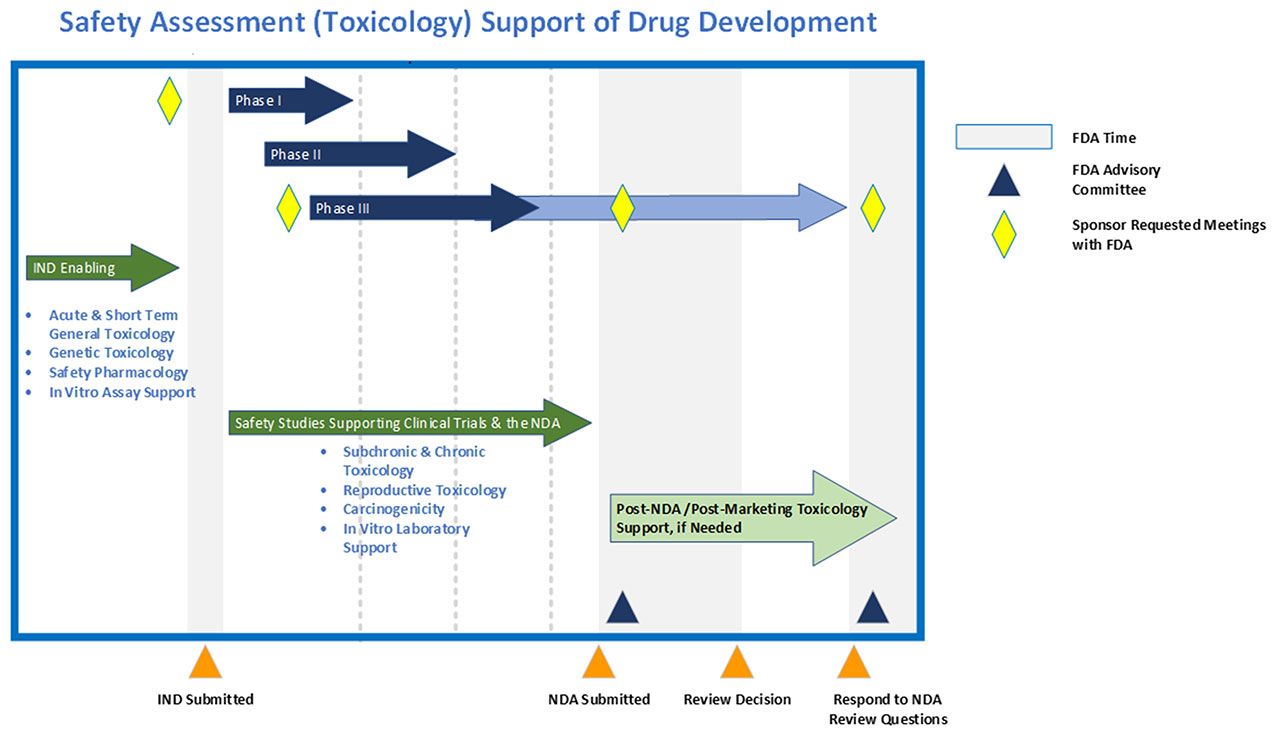Toxicology: Ensuring Drugs are Safe for People
Accelerated drug development timelines must accommodate all crucial elements of nonclinical safety studies.
MOTORTION - STOCK.ADOBE.COM

While the process for developing human therapeutics is long, complex, and requires considerable resources, in urgent situations such as COVID-19, the pace of development can move much faster. Steps that ordinarily take years were completed in months. Whether for a cardiac drug or a COVID-19 drug, the development process must show that the drug has an effect on the disease it is being used to treat and is safe for human use.
Safety testing must be a priority during the discovery, nonclinical phase, and clinical phases of drug development (Figure 1). While some nonclinical safety, or toxicology, testing is performed during the discovery phase, the majority of the toxicology testing occurs during the nonclinical phase and concurrently with the clinical phase. The goal of the toxicology testing is to determine, using animal models, if a potential new drug is safe to use in humans and to identify compounds that could potentially cause more harm than good.
Figure 1. Safety assessment (toxicology) support of drug development. NDA is new drug application. Figure courtesy of the author.

Preparing for the IND
The endpoint of the nonclinical phase for US drug candidates—the investigational new drug (IND) submission—features a summary of the toxicology work performed to support the administration of the potential new drug to humans in a Phase I clinical trial.
During the nonclinical phase, the following four types of studies generate data for the IND application:
- Short-term acute toxicology studies are conducted to determine what doses should be tested in longer-term animal-model studies.
- Repeat dose toxicology studies, which use the doses identified in the acute studies, are designed to administer doses to animal models daily for up to 30 days. These studies are typically run at doses many multiples above what a human would receive, with the goal of characterizing any adverse effects or toxicities that the potential new drug may cause. Key endpoints for these studies include determining how much drug the animals are exposed to, what effect the drug may cause on their appearance (such as changes in their coat, eating habits, body weight, etc.), what effect the drug may have on their blood chemistry (such as serum chemistry, hematology, and coagulation changes), and what effect the drug may have on their organs (also known as the histopathology evaluation).
- Safety pharmacology studies are designed to see if the new drug has any effects on the cardiovascular system, the respiratory system, and the nervous system.
- Genetic toxicology studies are designed to assess whether the new drug can damage the animal and/or human DNA.
Once the studies are conducted, the data are assessed to estimate a safe starting dose for the Phase I clinical trials. Once a positive risk assessment determines an appropriate dose for Phase I clinical trials and any adverse effects are identified in animal toxicology studies, the drug development company files an IND application. If FDA reviewers agree with the assessment of the potential new drug, the Phase I clinical trials in humans can be initiated. An unfavorable toxicity profile at the nonclinical stage of drug development is a common reason why a compound fails and does not progress in the drug development process.
Studies support clinical trials
As drug candidates progress through clinical trial phases, sponsors must continue toxicology testing and data collection for a new drug application (NDA), mindful of the requirements of different global regulatory authorities where submissions may be planned.
While the potential new drug is administered to people during the clinical phases of development, the safety testing of the compound in nonclinical animal models must continue for the same duration as the clinical study. For example, if the duration of treatment of patients in a clinical trial is months, nonclinical safety studies, typically three to nine months in duration, will be conducted to cover the time patients will be treated. The typical nonclinical toxicology studies conducted during the clinical phase of development include the following:
- Sub-chronic and chronic toxicology studies are similar to the repeat dose toxicology studies used to support the IND. However, they are run at longer durations (typically three, six, nine, or 12 months) and are used to assess the long-term effects of the drug on animal models.
- Reproductive toxicology studies are designed and conducted to determine if the potential new drug has any effects on male and female reproductive organs, male and female fertility, or on a developing fetus. Additionally, these studies are conducted before the drug can be given to women that can bear children.
- Carcinogenicity studies are typically conducted in rats and mice where the potential new drug is given to the animals for the majority of their life span. The studies are typically two years in duration and are used to determine if a lifetime exposure to the potential new drug can cause cancer or tumors.
Extensive data reviews are conducted to determine the drug candidate’s efficacy and safety, and if the data point to a favorable risk-benefit assessment, the company will submit an NDA to FDA or similar application to other regulatory authorities for market approval.
Nonclinical study designs
While nonclinical animal toxicology studies follow accepted designs, the following crucial points must be considered:
- What animal species to use? The toxicology studies are typically required to be conducted in two species: one rodent and one large animal species. The specific species selected depends on several factors including which species are most sensitive to the effects of the potential new drug and which best mimics the metabolism of humans.
- How should the drug be administered? Often the avenue selected to administer the potential new drug to animals mimics the avenue that will likely be used in humans. This may include oral, intravenous, intramuscular, or intermuscular routes of administration.
- What special endpoints (biomarkers) should be included? While there are expected endpoints that are included in almost every study (clinical observations, blood chemistry, histopathology, measuring food consumption, and body weights), the type of compound the potential new drug—chemical, antibody, protein, vaccine, RNA, etc.—can dictate what other endpoints will be measured. These can include assays to measure immunogenicity, cytokines, enzyme activity, special cell types, and immune function.
The majority of nonclinical toxicology studies must be conducted according to good laboratory practices (GLPs) and include a robust quality management and documentation system that ensures the validity, integrity, and reliability of the nonclinical safety data submitted for regulatory evaluation and approval.
Accelerating development timelines
Rapid advancement of the availability of drugs that treat serious diseases and unmet medical needs are in everyone’s interest, especially when the drugs are the first available treatment or if the drug has advantages over existing treatments. FDA’s approaches to speed development—priority review, breakthrough therapy, accelerated approval, and fast track—have proven successful in bringing treatments, especially for unmet and orphan designations, to market quickly.
The COVID-19 pandemic has offered the public a glimpse of how drug and vaccine development can be accelerated during a public health emergency. The scientific response to COVID-19 has been unprecedented, from both clinical and nonclinical contributors. The global research community—which includes government labs, academic researchers, contract research organizations (CROs), and biotech and pharmaceutical companies—is racing to find solutions, and regulatory agencies are helping to accelerate these vaccines and treatments.
In 2020, FDA launched the Coronavirus Treatment Acceleration Program (CTAP) (1), an emergency program designed to speed up the regulatory processes for SARS-CoV-2 research without compromising safety. A notable change in CTAP is that it now consolidates the typical pre-IND meeting request and package development process into a single step to save time. The pre-IND meeting request will be expedited and prioritized based upon the completeness of the submission and scientific merit.
For drug developers, outsourcing the nonclinical toxicology work to a CRO can have a positive impact on the pace of research during the pandemic. Online scheduling of studies, accelerated reporting, remote study monitoring, and live streaming of key events allow studies to progress faster than before. This versatility has been extremely helpful to pharma companies as they race to find therapies and treatments in record time.
Safety testing remains a top priority
Nonclinical toxicology is an important component in the drug development process and ensures that safe drugs are made available to people. A sound nonclinical toxicology program should address all regulatory authority concerns and ensure that time and resources are properly used.
Rapid research and development efforts in 2020 demonstrated that bio/pharma companies must be positioned to move swiftly through the drug development process with unwavering commitment and oversight to ensure the compounds slated for the clinic are safe. The combined efforts of pharmaceutical companies, governments, and CROs were instrumental in reducing the development timeline from a decade or more to one year for some R&D programs. Time will tell what impact the current pandemic has on the overall approval for all therapeutics for all diseases outside of a global pandemic, but regardless of what these changes bring, safety will always be a priority.
Author’s Note
Charles River scientists Steven Bulera, PhD; DABT, Rebecca Walker Comba, PhD; and Sam Chuang, PhD contributed to this article.
Reference
1. FDA, “Coronavirus Treatment Acceleration Program (CTAP),” www.fda.gov, accessed Jan. 12, 2021.
About the Author
Shannon Parisotto, MBA, is the corporate senior vice president of Charles River Laboratories.
Article Details
Pharmaceutical Technology
Vol. 45, No. 1
February 2021
Pages: 54–57
Citation
When referring to this article, please cite it as S. Parisotto, “Toxicology: Ensuring Drugs are Safe for People,” Pharmaceutical Technology 45 (2) 2021.

Pharmaceutical Tariffs Are Imminent: How Industry is Bracing for Impact
April 16th 2025On April 14, 2025, the Trump Administration launched a national security-driven investigation into pharmaceuticals, a move that will likely result in tariffs being placed on pharmaceutical drugs, ingredients, and other components that are imported from outside of the United States.